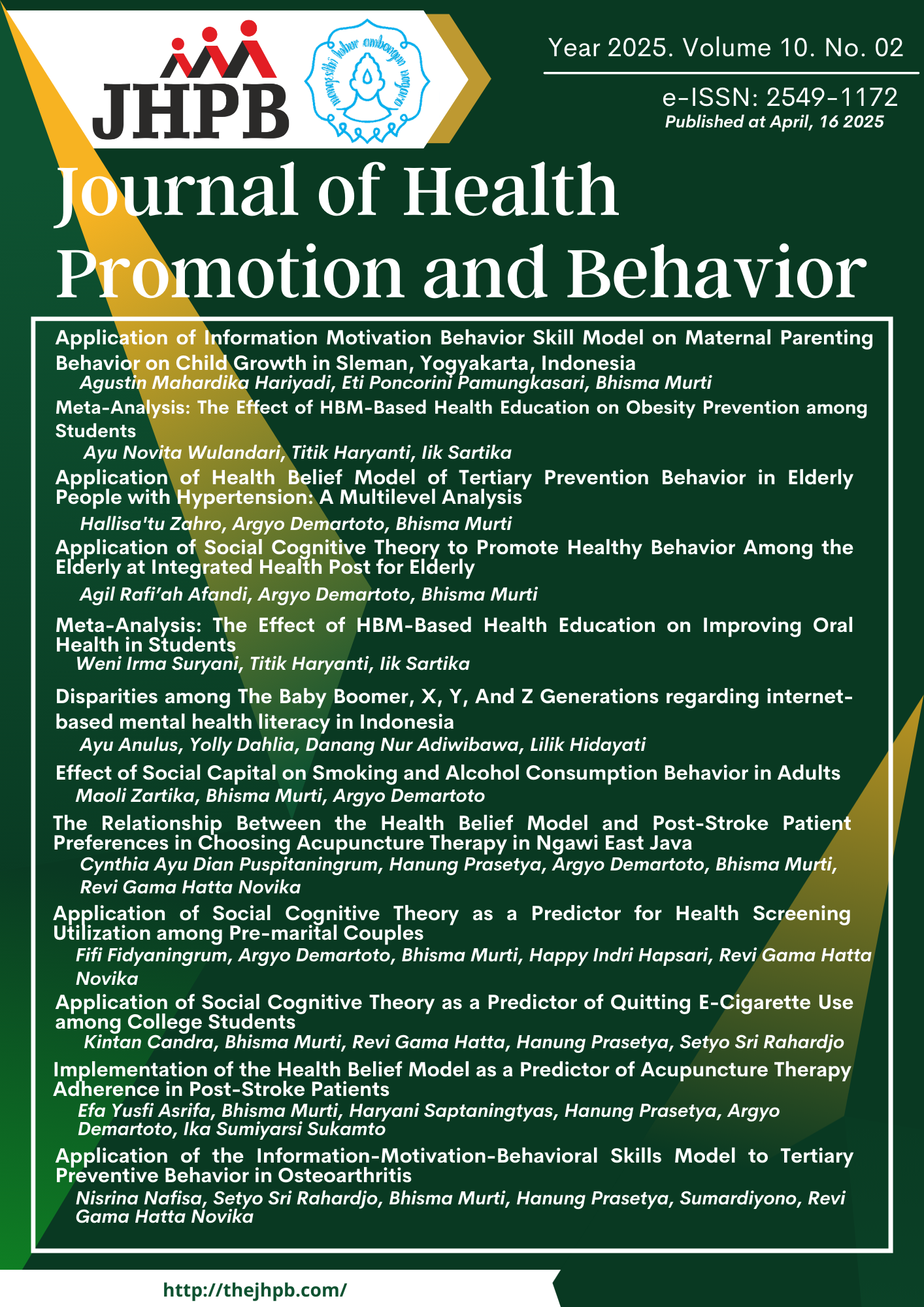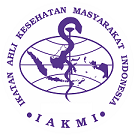Application of Health Belief Model of Tertiary Prevention Behavior in Elderly People with Hypertension: A Multilevel Analysis
DOI:
https://doi.org/10.26911/thejhpb.2025.10.02.03Abstract
Background: The health of the elderly is influenced by various risk factors and changes from within themselves and their environment. These various conditions can affect health problems, functional status, level of independence and quality of life of the elderly. Deterioration of health in the elderly can manifest in a variety of diseases, including hypertension. Efforts to control the incidence of hypertension can be done through the provision of health education about hypertension, which aims to raise awareness of hypertensives about the concept of hypertension, complications, and how to overcome. This study aims to examine the application of the Health Belief Model (HBM) as a predictor by taking into account the contextual effects of the Elderly Integrated Healthcare Posts in Kepanjen, Malang, East Java, Indonesia.
Subjects and Method: This study was an observational analytical study with a cross-sectional approach using a multilevel analysis model. The population in this study was all elderly people with hypertension at the Elderly Integrated Healthcare Posts in the working area of Kepanjen Community Health Center, Malang, East Java, Indonesia. The sample in this study was 200 elderly with hypertension at the Elderly Integrated Healthcare Posts in the Kepanjen Community Health Center Working Area, Malang, East Java, Indonesia. The study used the Stratified Sampling technique at the healthcare level (Elderly Integrated Healthcare Posts), and Stratified Random Sampling in the selection of the elderly.
Results: Tertiary prevention behavior among elderly with hypertension increased with high self-efficacy (b= 0.57; CI 95%= 0.39 to 0.73; p<0.001), cues to action (b= 0.27; CI 95%= 0.35 to 1.71; p<0.001), female gender (b= 0.76; CI 95%= 0.10 to 0.42; p<0.001), age 70-90 years (b= 0.37; CI 95%= -0.01 to 0.75; p= 0.060). Integrated health posts for elderly on the tertiary prevention behavior of hypertension. The Integrated Healthcare Posts had contextual effect on tertiary prevention behavior (ICC=29.87%; p<0.001).
Conclusion: Tertiary prevention behavior of hypertension in the elderly increases with high self-efficacy, cues to action, female gender, age 70-90 years.
Keywords:
hypertension, elderly, self-efficacy, cues to actionHow to Cite
References
Patel, Goyena R (2019). Edukasi kesehatan dalam meningkatkan kepatuhan mi-num obat pada lansia hipertensi. J of Chemical I and Modeling, 15(2): 9–25. Doi: 10.31539/jks.v6i2.5961
Rayanti RE, Nugroho KPA, Marwa SL (2021). Health belief model dan management hipertensi pada pende-rita hipertensi primer di Papua. Pro-mot J Kesehat, 6(1): 19–30. Doi: 10.30651/jkm.v6i1.7065
Fithri R, Athiyah U, Zairina E (2021). The development and validation of the he-alth belief model questionnaire for measuring factors affecting adherence in the elderly with hypertension. J Basic Clin Physiol Pharmacol, 32(4): 415–419. Doi: 10.1515/jbcpp-2020-0459
Ma C (2018). An investigation of factors influencing self-care behaviors in young and middle-aged adults with hypertension based on a health belief model. Heart and ung, 47(2): 136–141. Doi: 10.1016/j.hrtlng.20-17.12.001
Setiyaningsih R (2016). Health belief model: determinantsof hypertension prevention behaviorinadults at com-munity health center, Sukoharjo, Central Java. J of Health Promotion and Behavior, 01(03): 160–170. Doi: 10.26911/thejhpb.2016.01.03.03
Arindari DR, Suswitha D (2020). Health belief model factors to medication adherence among hypertensive pati-ents in punti kayu public health center Palembang, Indonesia. JurKeper, 11(1): 22–27. Doi: 10.2- 2219/jk.v1-1i1.10483
Fauziah Y (2021). Hubungan antara efikasi diri dengan manajemen perawatan diri pada penderita hipertensi di puskesmas indrapura kabupaten Batubara Tahun 2019. J Midwifery, 4(2).
Olpah M, Riduansyah M, Manto OAD (2023). Hubungan efikasi diri dengan kepatuhan diet pada pasien hipertensi Grade I. J Persatuan Perawat Nasio-nal Indonesia (JPPNI), 7(3).
Rusmadi N, Pristianty L, Zairina E (2021). Validitas dan reliabilitas kuesioner kepatuhan pengobatan pasien lansia dengan hipertensi berdasarkan teori health belief model. 7(3): 60–68. Doi: 10.25077/jsfk.8.1.60-68.2021
Hoky R, Siahaan B, Utomo W (2022). Hubungan dukungan keluarga dan efikasi diri dengan motivasi lansia hipertensi dalam mengontrol tekanan darah. Holist Nurs Health Sci, 5(1): Doi: 10.14710/hnhs.5.1.2022.43-53.
Williams N (2021). Medication beliefs and behaviors of hypertensive caribbean immigrants living in New York City Walden University. Walden Disser-tations and Doctoral Studies. 11443. https://scholarworks.waldenu.-ed-u/dissertations/11443. Diakses 21 Maret 2024.
Fitriah, Hermanto H, Katmini K (2023). Application of HBM theory (health belief model) to preventing behavior of hypertension complications in pub-lic health center raas, Sumenep Re-gency. J for Quality in Public H, 5(1): 149–159. Doi: 10.30994/jqph.v5i1.263
Joho A (2021). Using the health belief model to explain the patient’s com-pliance to anti-hypertensive treatment in three district hospitals - dar es salaam, Tanzania: A Cross Section Study. East Afr Health Res J, 5(1): 50–58. Doi: 10.24248/eahrj.v5i1.651





